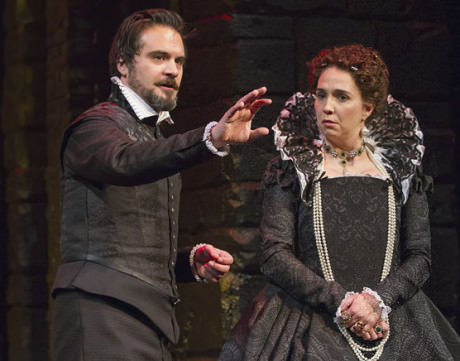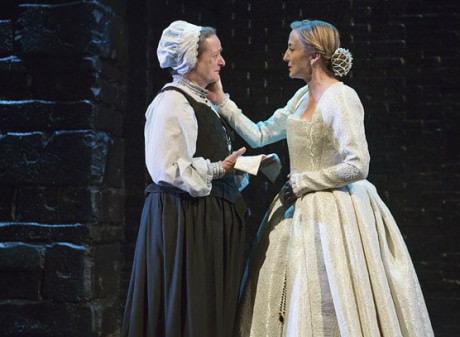Mary, Mary quite contrary, how does your garden grow? With silver bells, and cockle shells, and pretty maids all in a row.” This nursery rhyme is often said to be about Mary Stuart. The pretty maids all in a row were her ladies, known as the “Four Maries” who were famous for their beauty and devotion to their queen. Schiller’s Mary Stuart, produced at The Folger, features two queens, Mary and Elizabeth I. Two powerful rivals. Two female rulers. And two actresses who prove that you can scream, plot, kill, die, and still be every inch a queen.

This is one of those rare productions in which every element shines like a beautifully polished jewel. It is, in every sense, a masterpiece. Friedrich Schiller, in writing his play, apparently studied a number of history books and then threw them out. But why worry about history when you have great drama? Mary Stuart is the poetic truth about Mary, and that is what matters in the theater.
At first, we see a prison. Mary’s faithful retainer, Hanna Kennedy (the wonderful Nancy Robinette) is in distress (again); they are taking Mary’s jewels (again); they are rifling through her papers (again); they are treating Mary like the Elizabethan equivalent of a teenage drug addict who has just failed her nineteenth stint in rehab and can never be trusted (again). Mary handles the situation with aplomb, noting with fairness that jewelry does not make the queen. In fact, as Mary, Kate Eastwood Norris is so vital, so clever, and so self-possessed, that I almost thought she would escape. However when Mary’s nemesis, Lord Burleigh (Rajesh Bose) fixed her with his glowing and extremely malevolent glare, I knew that it wasn’t going to turn out any better this time around.
Holly Twyford’s Queen Elizabeth is magnificently complicated, a woman who is so astute she has almost crushed her heart out of existence. Her lover, the Earl of Leicester (Cody Nickell), has practically been driven mad by years of her manipulation, and although Leicester cuts a sorry figure here it is hard not to have sympathy for such an obvious prisoner of love. Nickell catches every nuance of the Earl’s oily grandeur, reminding us that then as now to be the consort of a formidable woman is no sinecure.
Plots are laid; betrayals mount; love is won and lost; all the familiar tropes of Elizabethan drama are here, but Peter Oswald’s colloquial translation brings a modern twist to the proceedings, which adds to the humor as well as the sadness. You could hear the D.C. audience chuckling as Sir William Davison (Todd Scofield) explains to Queen Elizabeth that he doesn’t want to be the one to condemn Mary because after all, he hasn’t been at the job that long.
Director Richard Clifford transports us to another time and place, to a world where two women, each extraordinary in her own way, fight for survival and end up destroying each other. Elizabeth did take Mary’s life. But Mary’s death takes Elizabeth’s soul.
Louis Butelli is first-rate as Mary’s jailer, Sir Amias Paulet, a man who has scruples and somehow manages not to die for them. Paul-Emile Cendron plays Mortimer, the exemplar of all the open-faced, idealistic young men who flocked to Mary’s cause and ended up dead. Cendron avows Mortimer’s passions in a kind of fury, in a performance which becomes ever more riveting as he loses his grip on reality. Craig Wallace as Shrewsbury has a compassion for Mary which is marvelous to behold, and tragic because it comes too late. Ray Dooley (Melvil), as one of Mary’s last and best friends, is visibly devastated by what is about to happen, but is somehow able to overcome his horror for the woman he still loves. Jeff Keough (Drugeon Drury and Sheriff) and Nathan Winkelstein (O’Kelly and Sheriff) perform with grace and subtlety, as they provide the essential context to understand the forces which surrounded Mary and ultimately determined her fate.
Ray Dooley brings a delightful comic touch as Count Aubespine, and Todd Scofield is equally winning as Count Bellievre, his partner in crime, as they try to convince Elizabeth to marry their lord, the Duke of Alencon. It should be noted that like many royal marriage prospects, Alencon was much less attractive than he was alleged to be (Elizabeth called him her frog) and in the end Elizabeth rejected him too, obtaining her stated heart’s desire of dying a virgin and being about as happy about it as could be expected.
The real Mary was both more and less guilty than she is portrayed here. Many historians do not blame her for the death of Darnley, but the evidence that she encouraged the assassination of Elizabeth is somewhat more convincing. It is worth remembering that Mary, brought up in luxury to believe she would be Queen of England, Scotland and France, saw her secretary, David Rizzio, murdered right before her eyes as she was pregnant. She may (or may not) have been raped by Bothwell. She ended her life in chronic pain, with a recurring leg problem which rendered her practically disabled. It is quaint to imagine a Queen of Scots with PTSD, but perhaps not far off the mark.
Tony Cisek’s Scenic Design is full of compelling contrasts. We see Mary in a dark prison at first; then a striking reversal as we see Elizabeth’s gigantic throne in a room with gleaming golden walls. After Elizabeth’s disastrous meeting with Mary, we see Elizabeth in the same room, but the gold is now muted. The furniture is that beautifully carved dark brown we often see in Elizabethan plays, but it has never looked more appropriate.
Mariah Hale’s costumes, as always, are not only a visual treat, but contribute in many ways to our understanding of the characters. Mary is always seen with a large cross dangling from her girdle. Late in the play, when she is at her lowest ebb, we see Elizabeth’s head covered in white cloth, instead of the intricately jeweled hairstyles we have come to expect.

Rob Denton’s lighting is especially fine at the end, when we see Elizabeth alone, in a spotlight. His work complements the mood of every scene. The Music Composition and Sound Design (Patrick Calhoun) is staggeringly effective.
In Mary Stuart, it is especially exciting to see two dynamic women, two forceful personalities, in a time when women’s lives and opportunities were so restricted. Perhaps that is one of the great fascinations of this remarkable play.
Running Time: Two and a half hours, with one 15-minute intermission.
Mary Stuart plays through March 8, 2015 at Folger Theatre at the Folger Shakespeare Library—201 East Capitol Street, SE, in Washington, DC. For tickets, call the box office at (202) 544-7077, or purchase them online.
Rating:





